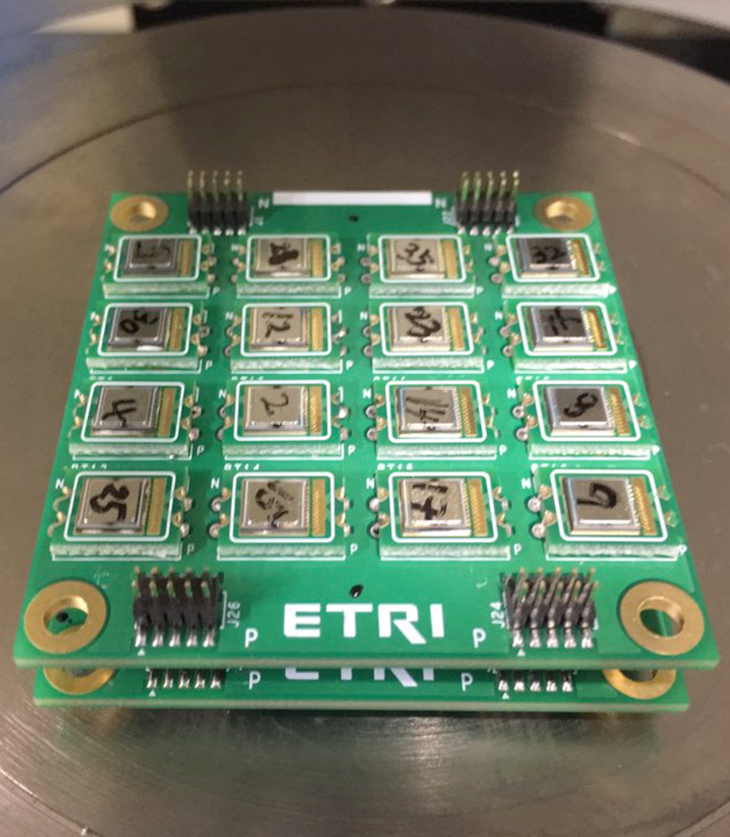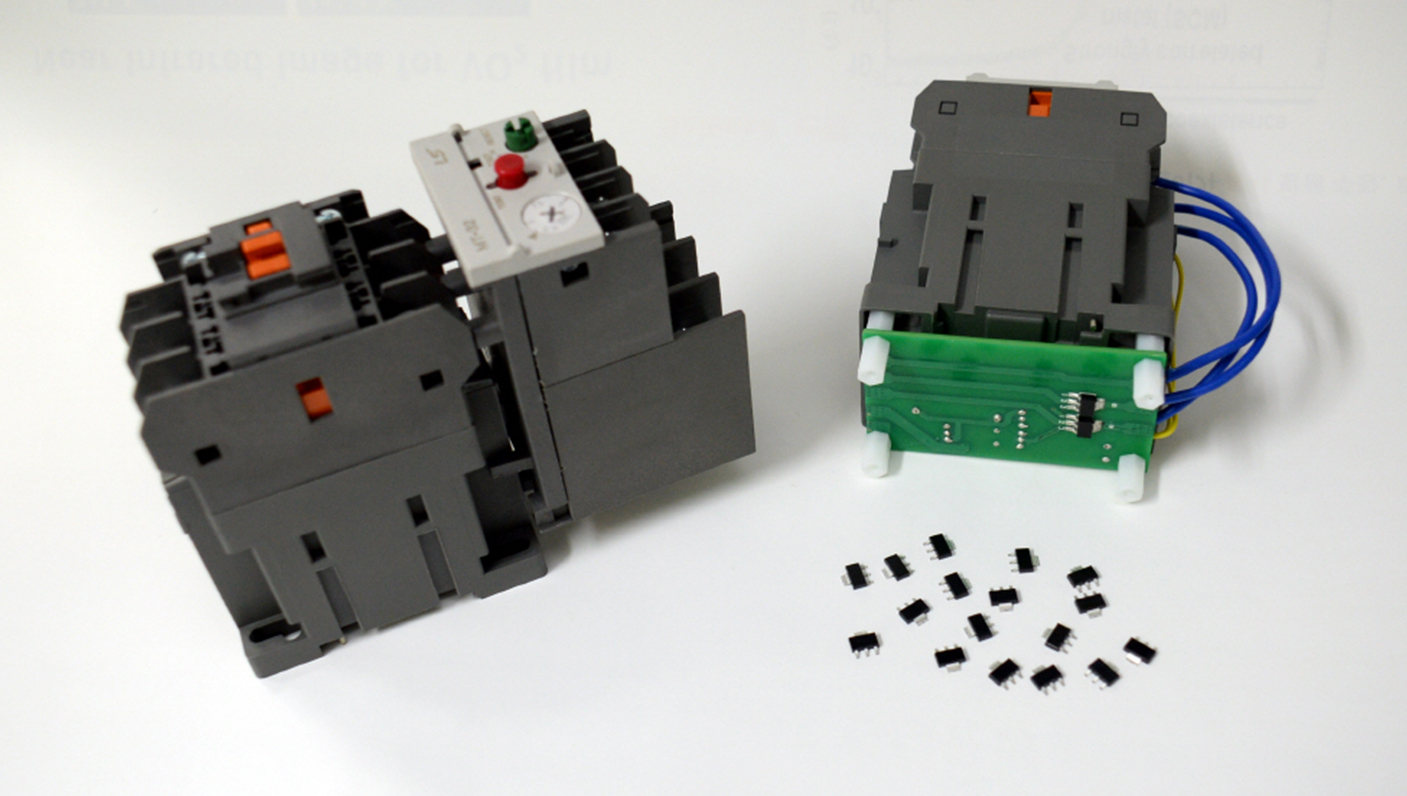VOL.58
January 2020


ICT Trend — beta voltaic battery technology
Development of a
beta voltaic battery
that will last
for 100 years
beta voltaic battery technology
The box-office hit “Pandora” attracted about 4.5 million viewers in late 2016. The huge success of the film was partly attributable to the growing public interest in the safety of nuclear power generation. The film tells the story of the meltdown of an atomic power plant caused by the strongest-ever earthquake. It portrays the plant workers’ desperate efforts to prevent a secondary explosion at the risk of being exposed to radiation. What would happen if the scenes from “Pandora” occurred in reality?


The beta voltaic battery with a 100-year lifespan developed by ETRI.
A battery that will last for 100 years without the need for recharging!
An examination of the inside of a nuclear reactor requires a sensor to detect potential leaks of radiation. In the event of a real explosion at a nuclear reactor, however, the entire electricity supply would be cut off, and even the emergency power supply would die out within several hours. As such, there would be no way of finding out about the situation inside the reactor. It is against this background that a nuclear reactor needs an “independent power source” in the event of a complete power blackout.
There is another example of the importance of long-lifespan batteries. Some people who suffer from arrhythmia have a pacemaker implanted in their chest, which automatically controls their heartbeat. The problem is that such patients may have to undergo surgery on a regular basis because the battery in the device only lasts for five to eight years, so a battery without a lifespan would be a real blessing for them.
One such battery ? which can work for up to 100 years without recharging ? has been developed by a research team of ETRI. It is a beta voltaic battery. As its name indicates, the battery utilizes beta particles, which are emitted along with alpha and gamma particles during the decay of radioactive isotopes. Beta particles are less harmful to humans than other radioactive particles, and shielding against them is also possible. The beta voltaic battery developed by ETRI’s researchers generates current and voltage by having a semiconductor absorb beta rays emitted from radioactive isotopes. In this respect it is similar to the solar cell. Beta rays are identical to electron rays, which are used in vacuum tube televisions. Viewing a vacuum tube television for many hours results in sore eyes, but this problem can be fixed by applying aluminum foil as a shield against electron rays.

The Beta voltaic battery can be installed in places that are inaccessible to humans.
The most outstanding characteristic of beta voltaic batteries is that they do not need recharging, which is what distinguishes them from the lithium ion batteries used in smartphones. Unlike smartphone batteries, which require recharging almost every day, beta voltaic batteries a have long lifetime because users can operate them only when they are needed. In fact, beta voltaic batteries can last for up to 100 years. With the current technology, the hourly efficiency of a beta voltaic battery is one microwatt, which means it can give out 876,000 microwatts while being operated on a 24-hour, 365-day basis for 100 years. The goal of ETRI’s researchers is to increase battery efficiency to 5 microwatts per hour.
Another salient characteristic of the beta voltaic battery is that it utilizes the N-63 isotope, whereas the lithium ion battery is based on Li ions. This method also entails certain difficulties. For example, it is difficult to use beta voltaic batteries in everyday life because shielding against radiation is necessary. However, they can be used in nuclear power plants, the Polar Regions, and space, as well as for military uses. The ETRI team has developed a technology for transforming radioactive rays into energy, while researchers at the Korea Atomic Energy Research Institute (KAERI), ETRI’s partner, have developed the isotopes needed to make the beta voltaic battery.
The researchers are now focusing on improving the basic technology, with the aim of increasing the battery’s power fivefold. They plan to apply the battery to medical treatments, such as pacemakers, and disaster control. It will also be possible to install the beta voltaic battery in sensors that detect cracks and other types of damages inflicted by earthquakes upon major structures like dams, tunnels and atomic power plants. Notably, it will be particularly effective to install sensors equipped with a small battery inside large structures to which human access is limited or dangerous.

The beta voltaic battery will serve as a key communications energy source.
An alarm bell sounds when battery-equipped sensors send signals upon the outbreak of an earthquake or other major impacts. It is on such occasions that the beta voltaic battery proves its effectiveness. Researchers have stated that the battery consumes a minimal amount of electricity, which enables it to last for about 100 years. Attracted by this and other advantages, many countries are competing to develop a beta voltaic battery. To that end, the Defense Advanced Research Projects Agency of the US has provided research funds to Cornell University, while Russia is also conducting research utilizing Ni-63 and a diamond semiconductor.
ETRI’s researchers use power semiconductor that uses silicon carbide, which provides high voltage and is very powerful, thus enabling its use in extreme conditions. ETRI is equipped with a Fab dedicated to semiconductors that allows it to design the production process for wafer. The production process is, of course, rather demanding. For instance, the production process for silicon carbide requires a temperature of 2,000 degrees Celsius, while that for silicon ranges from 800 to 900 degrees Celsius.
A beta voltaic battery plays the role of a well, as it keeps filling up the secondary battery. This system guarantees the supply of consistent output because the beta voltaic battery replenishes the secondary battery whenever necessary. In cases where a device requires less electricity power than the output of the beta voltaic battery, the latter can be separated from the secondary battery. In other words, the beta voltaic battery provides power and sends electric signals only when the sensor works. Likewise, the beta voltaic battery is a key energy source for communications.
This article is quoted from Technology That Will Change the World, Future Brought by Digital Technology, ETRI’s Easy IT series (2018).

Future Brought by Digital Technology
Written by Kilho, Chong · ETRI's Public Relations Section Published by Contentshada
Future Brought by Digital Technology issued by ETRI aims to help readers better understand what the Fourth Industrial Revolution means to them and to introduce various ICT trends so that readers can have a fascinating glimpse of what might happen in the near future. This book will be a reliable guide for anyone who wants to learn and understand how to adapt to the rapidly changing, unpredictable world driven by technological innovations and flexibly respond to risks that might be faced going forward.



